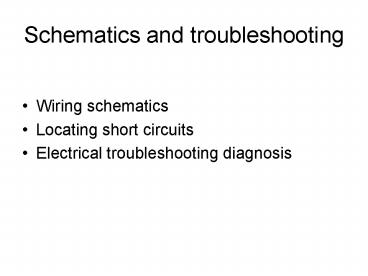Schematics and troubleshooting - PowerPoint PPT Presentation
1 / 14
Title:
Schematics and troubleshooting
Description:
Common areas of potential damage: Wiring around sources of high heat ... Previous repairs. Verify complaint. Visual inspection ... – PowerPoint PPT presentation
Number of Views:49
Avg rating:3.0/5.0
Title: Schematics and troubleshooting
1
Schematics and troubleshooting
- Wiring schematics
- Locating short circuits
- Electrical troubleshooting diagnosis
2
Wiring schematics
- Complex schematics are usually broken down to
individual circuits - Schematics of individual circuits show
- Power side
- Ground side
- Splices
- Connections
- Electrical components
- Some information may be referenced in another
circuit schematic
3
Wiring schematics
- Wire coloring is abbreviated (abbreviation is not
necessarily standardized) - First color is the base color
- Second color is the trace or stripe and separated
by a / - Wire size is usually noted
- Connectors are denoted by a symbol and numbered
4
Wiring schematics
Always verify wire color coding on vehicle Dont
assume schematic color is correct
5
Wiring schematics
- Switches are always drawn on diagrams in their
normal position - Normally open N.O.
- Normally closed N.C.
- Poles refer to number of circuits completed by
switch - Throws refer to number of output circuits
6
Wiring schematics
7
Schematic symbols
8
Wiring schematics
9
Wiring schematics
10
Locating short circuits
- Short circuit an electrical connection to
another wire or to ground before the circuit load
- Isolate circuit that is shorted from other
circuits that are powered by a common fuse - Determine whether short is constant or
intermittent
11
Locating shorts
- Install resetting circuit breaker in circuit or
- Install test light in place of fuse or breaker
- Installing either a circuit breaker or test light
allows the circuit to be powered while diagnosis
is completed - Check wiring schematic for circuit routing
12
Locating shorts
- Common areas of potential damage
- Wiring around sources of high heat
- Harnesses that are subject to movement
- Harnesses that are near the battery or exposed
under chassis, or passenger compartment - For intermittent shorts, wiggle harnesses and
connections while watching test light
13
Electrical troubleshooting diagnosis
- Information from customer
- When did problem start occurring?
- Under what conditions?
- Previous repairs
- Verify complaint
- Visual inspection
- Check for other non-operative circuits that may
be related
14
Electrical troubleshooting diagnosis
- Check TSBs for pattern failures
- Study circuit diagram and understand how circuit
works - Power source
- Ground path
- Power flow
- Isolate problem to a particular area of the
circuit - Determine cause and repair vehicle































